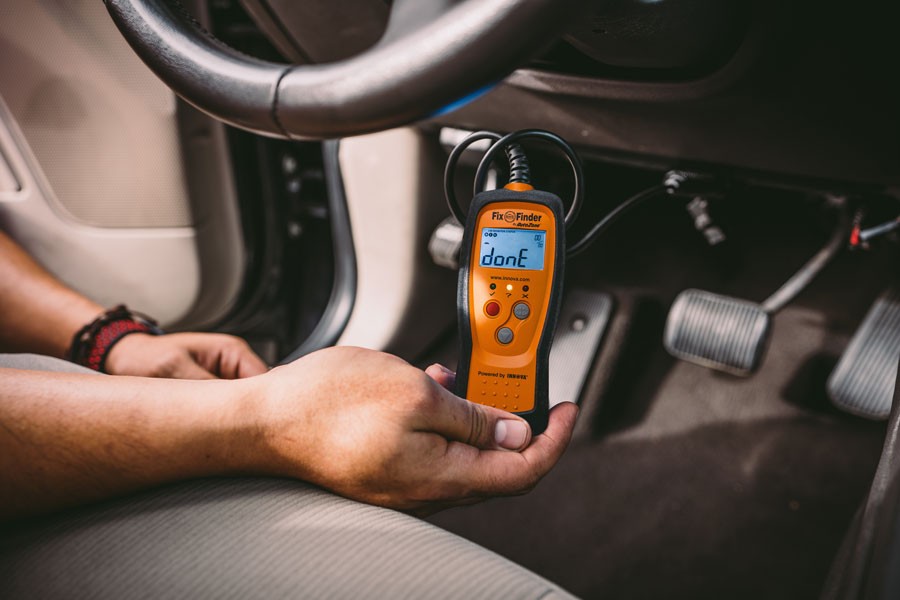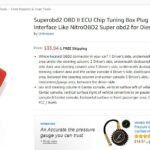Understanding your car’s health is becoming increasingly accessible thanks to On-Board Diagnostics II (OBD2) scanners. These handy tools plug into your vehicle’s diagnostic port and can reveal a wealth of information about your car’s systems, from engine performance to emissions. A common question for those new to OBD2 scanners is: Does Car Have To Be Running To Use Obd2 Scanner? Let’s dive into this and explore how to effectively use an OBD2 scanner.
Connecting Your OBD2 Scanner: Step-by-Step
Locating the OBD2 port is the first step. In almost every passenger vehicle, you’ll find a 16-pin, trapezoid-shaped female connector situated beneath the driver’s side dashboard. While this is the most common location, in some models, it might be in the center console or under the passenger side dash.
[paragraph break]
Connecting your OBD2 scanner is a straightforward process. The male end of the scanner’s plug is designed to fit the port in only one orientation, ensuring a correct connection. Simply align the trapezoidal shapes and gently but firmly push the plugs together. A slight wiggle can sometimes be helpful to fully seat the connectors.
[paragraph break]
For a standard diagnostic scan, follow these steps to connect your OBD2 scanner correctly:
- Turn Off the Ignition: Ensure your car’s ignition is completely off before you begin.
- Locate and Connect: Plug the OBD2 scanner into the diagnostic port.
- Turn Ignition to ‘ON’ (Engine Off): Turn the ignition key to the “ON” position. This position powers up the car’s electrical systems without starting the engine.
- Power Up: In most cases, the OBD2 port will provide power to your scan tool, and it will automatically turn on.
- Wait for Boot-Up: Allow the scan tool to complete its boot sequence.
[paragraph break]
After the initial setup, your OBD2 scanner may prompt you for additional vehicle information, such as engine size, VIN (Vehicle Identification Number), or instructions on whether to start the engine. Always follow the on-screen prompts for the best results.
Navigating the OBD2 Scanner Menu
Once your scanner has booted up, you’ll be greeted with a menu. The options available will vary depending on whether you have a basic code reader or a more advanced diagnostic tool. Common menu options include:
- Read Codes: This option is your gateway to understanding what’s going on with your vehicle. Selecting “Read Codes” will display Diagnostic Trouble Codes (DTCs). These codes are essentially error messages from your car’s computer, indicating a problem. The scanner might also provide a brief description of the fault. If there are multiple codes, the scanner will typically scroll through each one.
- Erase Codes: After you’ve addressed the issue indicated by a DTC, you can use “Erase Codes” to clear the fault codes and turn off the Check Engine Light. The scanner will usually ask for confirmation before clearing codes to prevent accidental deletion. Keep in mind that erasing codes doesn’t fix the underlying problem; it only clears the error message. If the issue persists, the code will likely return.
- Live Data: For scanners with live data capabilities, this is a powerful feature. It allows you to monitor real-time sensor readings from various parts of your car. This can be incredibly useful for diagnosing intermittent problems or observing how sensors are behaving under different conditions.
- Freeze Frame: Freeze Frame data captures a snapshot of sensor readings at the exact moment a DTC was triggered. This provides valuable context and can help pinpoint the conditions under which a fault occurred.
- Vehicle Info: This section typically displays basic information about your vehicle’s build and specifications, often read directly from the car’s computer.
- I/M Readiness: “I/M” stands for Inspection and Maintenance. This section is particularly relevant for emissions testing. It checks the status of various emissions-related systems and indicates whether your vehicle is ready for a smog check.
[paragraph break]
Most OBD2 scanners, whether handheld devices or Bluetooth/Wi-Fi models controlled by smartphones, are equipped with buttons for navigation. Arrow buttons help you scroll through menu options, a select button confirms your choices, and a back button allows you to return to the previous menu.
Decoding Diagnostic Trouble Codes (DTCs)
 OBD-II scanner displaying diagnostic trouble codes
OBD-II scanner displaying diagnostic trouble codes
When you choose “Read Codes,” the scanner will display a code, such as P0301. These codes might seem cryptic at first, but they follow a standardized format that makes them decipherable. A DTC always begins with a letter followed by four numbers.
[paragraph break]
The initial letter indicates the vehicle system where the fault originated:
- P (Powertrain): Relates to engine, transmission, fuel system, and emissions.
- B (Body): Concerns body control systems like airbags, power windows, and interior electronics.
- C (Chassis): Involves chassis systems such as suspension, brakes, and steering.
- U (Network): Indicates communication or network-related issues within the vehicle’s computer systems.
[paragraph break]
The numbers that follow the letter provide further details about the problem. The first number after the letter is either a 0 or 1. ‘0’ signifies a generic code, meaning it’s a standard code applicable across all vehicle manufacturers. ‘1’ indicates a manufacturer-specific code, meaning it’s defined by a particular carmaker.
[paragraph break]
The subsequent digits narrow down the system and specific fault. For instance, the third digit specifies the subsystem:
- 1: Fuel and Air Metering
- 2: Fuel and Air Metering (Injector Circuit)
- 3: Ignition System or Misfire
- 4: Auxiliary Emission Controls
- 5: Vehicle Speed Control and Idle Control System
- 7, 8, 9: Transmission-Related Codes
- A, B, C: Hybrid-Specific Codes
[paragraph break]
The last two digits pinpoint the specific component or circuit experiencing the issue. With hundreds of possible combinations, online resources and repair manuals are invaluable for detailed code definitions.
[paragraph break]
Let’s revisit our example code, P0301. Breaking it down:
- P: Powertrain (engine-related)
- 0: Generic code (common across manufacturers)
- 3: Ignition System or Misfire
- 01: Specifically, Cylinder #1
Therefore, P0301 indicates a Cylinder #1 Misfire in the powertrain system, and it’s a generic code.
Saving Money with OBD2 Scanners
Owning an OBD2 scanner can lead to significant savings in car repair costs. Here’s how:
- Early Problem Detection: When your Check Engine Light illuminates or you notice a performance issue, an OBD2 scan is the first step towards diagnosis. It provides clues about the potential source of the problem, even if it doesn’t pinpoint the exact cause.
- Smog Check Readiness: Before taking your car for a smog test, use the I/M Readiness function. It can identify potential issues that might cause your vehicle to fail the test, allowing you to address them beforehand.
- DIY Repairs: For straightforward issues, an OBD2 scanner can guide you to a DIY repair. For example, a P0138 code indicating a high voltage issue with the Bank 1 Sensor 2 oxygen sensor often means a sensor replacement is needed. With the code and some basic tools, you might be able to replace the sensor yourself, avoiding diagnostic and labor costs at a repair shop.
[paragraph break]
By empowering you to understand your car’s trouble codes, an OBD2 scanner allows you to be more informed when discussing repairs with a mechanic, or even tackle some repairs yourself.
FAQ: Using OBD2 Scanners
Does car have to be running to use OBD2 scanner?
No, in most common diagnostic scenarios, your car does not need to be running to use an OBD2 scanner. You can typically read trouble codes and access most functions with just the ignition turned to the “ON” position (engine off). This provides power to the OBD2 port and the car’s computer systems, allowing the scanner to communicate and retrieve data.
How do you use OBD II scanner?
- Plug the OBD2 scanner into your car’s diagnostic port (usually under the driver’s side dashboard).
- Turn your car’s ignition to the “ON” position (engine off).
- Power on your OBD2 scanner and follow the on-screen instructions to read codes, access live data, or perform other diagnostic functions.
How do I read my OBD scanner?
Navigate to the “Read Codes” option on your scanner’s menu. The scanner will display any active or pending Diagnostic Trouble Codes (DTCs). Note down the codes and use a code lookup resource (online or in your scanner’s manual) to understand their meaning. Remember the letter prefix (P, B, C, or U) and the numbers to accurately interpret the code.
Can you plug in OBD scanner while car is running?
While technically possible to plug in an OBD2 scanner while the car is running, it is generally not recommended. It’s best practice to connect the scanner with the ignition off, then turn the ignition to “ON” (engine off) to initiate the diagnostic process. In some cases, plugging in while the engine is running might not establish a proper connection, or could potentially cause electrical glitches. For reliable results, follow the recommended procedure of connecting with the ignition off.
[paragraph break]
Investing in an OBD2 scanner is a smart move for any car owner who wants to be more proactive about vehicle maintenance and repair. Whether you’re trying to decipher a Check Engine Light or simply want to monitor your car’s health, an OBD2 scanner is a valuable tool in your automotive toolkit. Consider exploring OBD2 scanners at automotive parts retailers or online to find one that suits your needs and budget.
